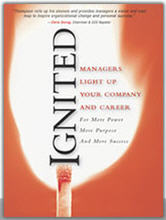I've been reading Vince Thompson's awesome book "Ignited!" and I want to share my findings with you. For me, one of the measures of a book is how likely I am to give someone else a copy (at the end of this post, you'll find my list of my "most often given" books). For the first time I can recall, I gave a copy of this book to a friend of mine before I even finished it -- Chapter 2 had my head buzzing.
 This book is geared toward middle managers, and Vince spends a lot of time on how to improve your ability to "lead in a limited space" (I love that phrase). However, I think anyone working in an organization can learn from it, whether they're managers or not (or in the middle or not).
This book is geared toward middle managers, and Vince spends a lot of time on how to improve your ability to "lead in a limited space" (I love that phrase). However, I think anyone working in an organization can learn from it, whether they're managers or not (or in the middle or not).
The book is divided into three parts, each with a distinct focus.
Figure out where the "You are here" dot is on your map
Section 1 focuses on you at a personal level -- figuring out what your opportunities, challenges, and key relationships are. This section does a great job of getting you to analyze where you are in your world, how you interact with others, and how your emotional responses can help or hinder your progress.
In the aforementioned Chapter 2, there's a technique which helps you map out your "universe" of relationships. In this chapter, Vince guides you through mapping your manager's universe, and assessing the quality of your relationships with key stakeholders to help you determine where you can contribute to make a big difference in your manager's success. The idea is that you will make your own life better if you're seen as a contributor to your manager's success. The simple tools and techniques here make this a piece of cake to do, and I think it's extremely powerful. This chapter alone was worth the price of the book for me (and you can apply the same process to your spouse, or other key relationships in your life).
Create value and light up the network
Section 2 is all about creating value for your organization by engaging others and honing your story, strategy, and interpersonal engagements to build your network of influence. In this section you focus on creating value in your organization by improving processes, becoming a better "connector" of people and ideas, figuring out what your market reality looks like, and more. There are also techniques to refine your story and clarify your strategy for driving success. Finally, you "Ignite" others in your organization to help support your activities, goals, etc. and take it to the streets.
My favorite chapter in this section deals with mapping out your landscape and tapping into the expertise of your customers to improve the quality of your "product." This also provides some good ideas for recruiting customers and partners as part of your team as evangelists.
Growing, accelerating, and sustaining
Section 3 discusses how (and why) to sell your story so you dramatically increase your impact and leverage beyond your immediate sphere of influence. This is a short, but meaty, section that discusses how to sell your ideas up the chain (both inside and outside your company), and how to effectively tackle and resolve the inevitable challenges that come up along the way. The discussion of the "right" and "wrong" ways to sell is very good.
My favorite chapter in this section is one on "Your Own Sense of Balance," which helps you understand how personal clarity, focus, and commitment are necessary but not sufficient for success. There is some advice here about leveraging your "personal board of directors," establishing a meaningful set of metrics to track your progress, and keeping yourself sane, safe, and sound so you don't burn yourself out once you've got the fire going.
In summary, I definitely recommend this book - spend a few minutes with it and you'll figure out why it's made its way on to my "most often given" list. Oh - and to find out more about Vince and his book, check out the companion site, BeIgnited (there is also an animated intro from Vince there - I thought it was very cool).
Dwayne's "most often given" books:
- "Mastery," by George Leonard - a great gift for graduates and people going through big transitions
- "Managing with Aloha," by Rosa Say - a tremendous book on management philosophy, told in a powerful way
- "Two Weeks to a Breakthrough," by Lisa Haneberg - the most effective, repeatable process I've found for making blowout progress toward any goal
- "Is Your Genius At Work?," by Dick Richards - an excellent "workshop style" book to help anyone trying to find their passion / raison d'etre
- "High Impact Middle Management," by Lisa Haneberg - a very practical (but still very insightful) set of techniques, particularly good for new managers
- "Ignited!," by Vince Thompson - see review above
By the way - I also give away (or refer people to) quite a few other books including all the ones you see in the left-hand column on my site, but these 6 seem to be the most "prescribed" books in my library.
Read More In addition to her comments and topic areas, I find that lack of good storage space is often a big factor in whether my "stuff" becomes clutter or not. If I don't have a place to put something, or if that place is inconvenient to get to, then that increases the likelihood that I'll create more clutter.
In addition to her comments and topic areas, I find that lack of good storage space is often a big factor in whether my "stuff" becomes clutter or not. If I don't have a place to put something, or if that place is inconvenient to get to, then that increases the likelihood that I'll create more clutter. 

 When I process my Inbox, I file them in a time-labeled Status subfolder. For example, I do monthly status reports so I have folders under status called Apr07, May07, etc.
When I process my Inbox, I file them in a time-labeled Status subfolder. For example, I do monthly status reports so I have folders under status called Apr07, May07, etc.